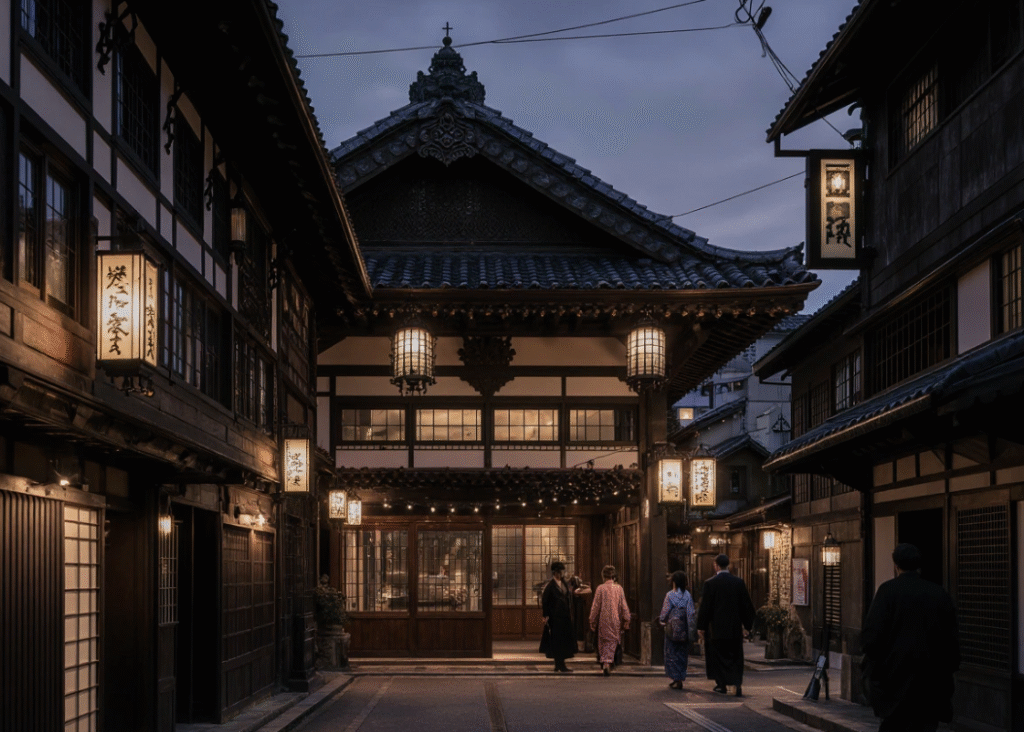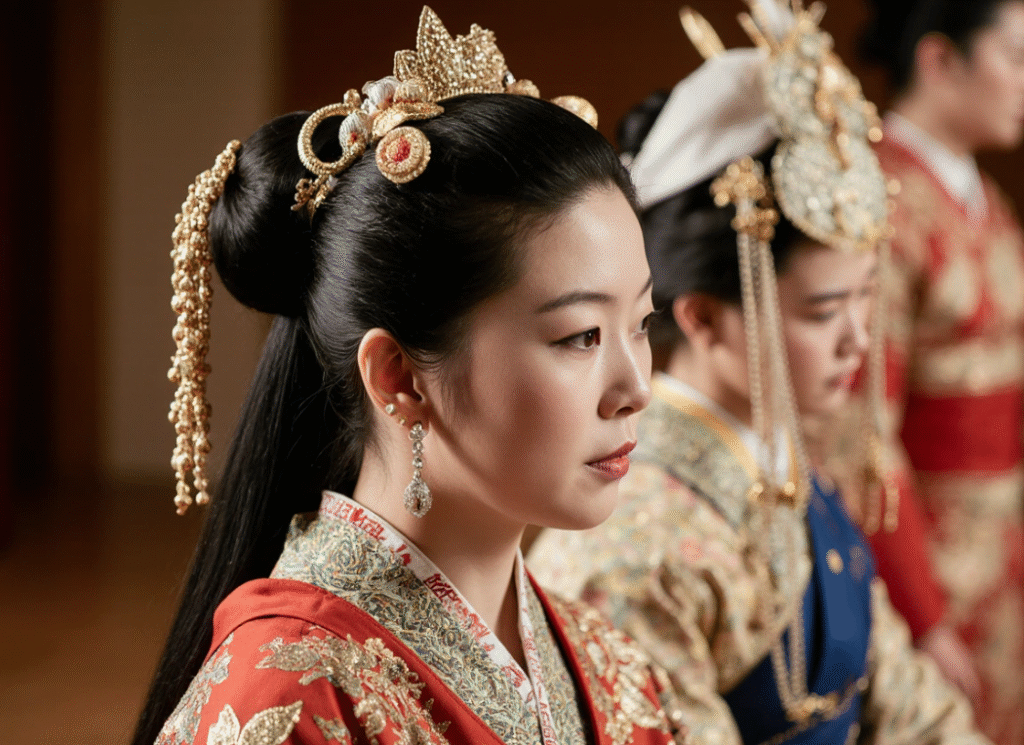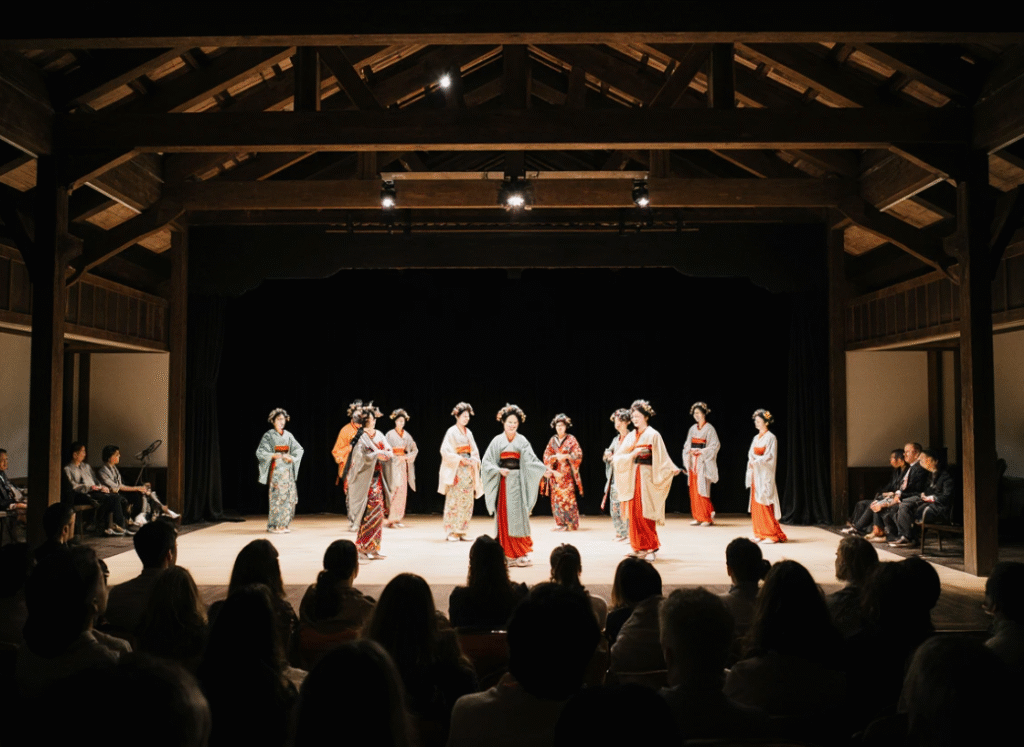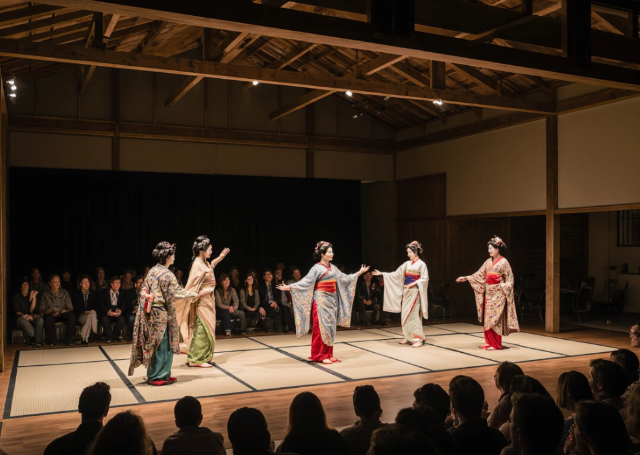The Pontocho Kobu Kaburenjo sits at the northern edge of one of Kyoto’s five historic hanamachi districts, hosting Kamogawa Odori performances each May since 1927. This venue preserves and showcases traditional Japanese dance in a setting where geiko and maiko still live and work as professionals, not historical reenactors.
More about Pontocho:
- Pontocho Park Guided Tours
- The Complete Guide to Pontocho: Kyoto’s Most Atmospheric Alley
- Geisha and Maiko in Pontocho: Tradition, Etiquette, and Okiya
What Makes Kobu Kaburenjo Theater Different?
Kamogawa Odori at Kobu Kaburenjo boasts the greatest number of performances among Kyoto’s five geisha districts, with over 184 total presentations since 1872. The theater exists specifically to preserve geisha dance traditions. When completed in 1927, the building was praised as “modern architecture with a taste of the orient”, blending Western construction techniques with Japanese aesthetics.

Night View of Pontocho Kobu Kaburenjo Theater in Gion
The performances occur annually from May 1-24, with three daily shows at specific times. Tickets for Kobu Kaburenjo range from ¥4,000 to ¥7,000 depending on seating and tea service options. Special seats offer better viewing angles, while regular seats provide a more economical option.
Unlike theaters designed for general entertainment, this Kamogawa Odori venue serves the Pontocho Kabukai Association as both performance space and community center. The intimate scale puts you close enough to see individual gestures, hear silk rustling, and feel the precision of centuries-old technique.
From Reclaimed Land to Pontocho’s Cultural Landmark
Four centuries ago, this land didn’t exist—it was part of the Kamo River. In 1670, the Edo government reinforced the riverbank, creating new land that became Pontocho. What started as reclaimed earth evolved into one of Kyoto’s most atmospheric entertainment districts.
The first Kamogawa Odori occurred in 1872, when Kyoto had just lost its status as Japan’s capital to Tokyo. City leaders organized a world exposition to attract visitors and revive the economy. This moment proved pivotal—for the first time, ordinary people could watch geisha dance without exclusive teahouse invitations.
The district could have faded when Tokyo became the capital. Instead, it doubled down on cultural preservation. From 1951 to 1998, performances at Pontocho Kaburenjo occurred twice yearly in spring and autumn. Though the schedule returned to once annually, the legacy endured. Think of it like a family restaurant that survives a highway bypass by focusing on quality rather than convenience—the commitment to excellence becomes the draw itself.
Case Study: In 2020, a first-time visitor from California arrived during the wrong week, missing the May performance window at Kobu Kaburenjo entirely. She rebooked her entire Kyoto leg around the following year’s Kamogawa Odori schedule, extending her stay from three to five days. The result: She experienced not just the performance but explored Pontocho’s riverside dining and visited three other Kyoto districts. Cost: Additional ¥85,000 in accommodation and meals. Her assessment: “Worth every yen because I planned properly the second time.”
Understanding the Performance Structure at Kamogawa Odori Venue
The show at Pontocho Kobu Kaburenjo is divided into two parts—the first presents dance drama, while the second showcases pure dance. Each movement communicates narrative through gesture, a technique refined over generations. Geiko and maiko wear kimonos specific to the season and story being told.
Live musicians accompany every performance using shamisen, drums, and flutes. The music sounds unfamiliar to Western ears—no conventional melody, more like punctuation and emphasis for the dancers’ movements. English program notes at Kobu Kaburenjo Theater provide context, though you won’t grasp every nuance.

Daytime View of Pontocho Kobu Kaburenjo Theater in Kyoto
The costumes represent months of hand-work by specialized artisans. Maiko wear more dramatic makeup than senior geiko. Hairstyles incorporate real hair styled around supports for maiko, while geiko wear wigs. Photography isn’t permitted during Kamogawa Odori performances, forcing presence over documentation—a restriction that improves the experience.
“Skip the pre-show tea ceremony unless you specifically want to say you did it. Groups move through quickly with too much noise to appreciate the ritual properly. Save that money for better seats at the actual performance. The dance is what matters.”
Comparing Pontocho Kobu Kaburenjo to Gion Kobu Kaburenjo Theater
| Feature | Pontocho Kobu Kaburenjo | Gion Kobu Kaburenjo Theater | Kitano Odori |
| Performance Name | Kamogawa Odori | Miyako Odori | Kitano Odori |
| Performance Period | May 1-24 | April | March-April |
| District Prestige | Medium | Highest (largest hanamachi) | Smaller/Traditional |
| Dance Style | Onoe school, modern elements | Inoue school, serene | Kabuki-influenced |
| Ticket Price | ¥4,000-¥7,000 | ¥5,500-¥7,500 | ¥6,000-¥7,000 |
| Total Performances | 184+ (most among all districts) | Lower | Lower |
Pontocho Kobu Kaburenjo occupies middle ground—incorporating contemporary dance elements while Gion Kobu Kaburenjo Theater maintains more formal traditions.
Planning Your Visit to Kobu Kaburenjo

Kamogawa Odori Dance at Pontocho Kobu Kaburenjo Theater
Performances at Pontocho Kaburenjo run May 1-24, 2025, with shows at 12:00 PM, 2:00 PM, and 4:00 PM daily. Tickets cost ¥4,000 for regular seats, ¥6,000 for special seats, or ¥7,000 for special seats with tea service. Online bookings for Kobu Kaburenjo Theater open April 4 at 10:00 AM JST through the official Kamogawa Odori website, with phone reservations available at 075-221-2025.
From Kyoto Station, take the Karasuma Line to Oike Station, transfer to the Tozai Line, and exit at Keihan Sanjo Station—about a five-minute walk to the Kamogawa Odori venue. Taxi fare from Kyoto Station runs approximately ¥1,000-¥1,200. The theater has no parking lot, so plan on public transit or walking from nearby accommodations.
During the first performance each day (starting around 11:10 AM), a maiko welcomes guests on the third floor of Pontocho Kobu Kaburenjo. This adds authenticity—a chance to see a working apprentice geisha before the main show.
“Arrive 20 minutes early to study theater architecture. Look for the gargoyle on the roof—it’s modeled after a bugaku mask. These architectural details tell the story of 1920s Japan trying to balance modernization with tradition.”
Three Critical Mistakes Visitors Make
Mistake #1: Booking Last-Minute Tickets for Kobu Kaburenjo
Many travelers decide to attend only after arriving in Kyoto, assuming 24 days of performances means plenty of availability. The reality: special seats at Pontocho Kaburenjo sell out within days of the April 4 sale opening. By early May, you face poor viewing angles or no tickets at all.
Price of this mistake: A unique cultural experience lost, plus the regret of knowing you had four weeks’ notice but didn’t act. If you settle for a different geisha performance at a tourist restaurant, you’ll pay ¥10,000-¥15,000 for something far less authentic. The emotional cost—explaining to friends back home that you “didn’t have time”—compounds the financial loss.
Mistake #2: Expecting Full English Accessibility
Visitors assume “English information provided” means comprehensive translation throughout the Kamogawa Odori performance. What you actually receive: a printed program with basic English summaries, nothing more. Without understanding Japanese, you miss narrative nuances and cultural references embedded in the dance.
Price of this mistake: Diminished appreciation of a complex art form. You spend the first 30 minutes checking your program repeatedly, trying to match stage action to brief English descriptions. By the time you accept the situation and just watch, you’ve lost a third of the performance to confusion. The ¥4,000-¥7,000 you paid delivers less value because you’re fighting comprehension rather than absorbing beauty.
Mistake #3: Treating Pontocho as Only a Theater Destination
Visitors attend the performance at Kobu Kaburenjo and leave immediately, missing the district’s actual character. Pontocho transforms after sunset when lanterns illuminate the alley and restaurants open riverside platforms. From May to September, these platforms (yuka) create Kyoto’s signature dining experience. You see geisha art but not geisha culture.
Price of this mistake: Missing the full atmospheric experience costs you one of Kyoto’s most memorable evenings. A riverside dinner ranges from ¥5,000-¥15,000 but creates lasting memories. Instead, you eat at a chain restaurant near your hotel for ¥2,000 and wonder why Kyoto felt “nice but not amazing.”
Behind the Curtain: Lesser-Known Facts About Kobu Kaburenjo
The theater’s gargoyle—that bugaku mask mentioned earlier—serves a specific purpose. In Buddhist and Shinto traditions, fierce faces ward off evil spirits. By placing this guardian on the roof, builders invoked protection for performers and prosperity for the district.
The distinction between geiko and maiko carries significance at Pontocho Kobu Kaburenjo. Maiko are apprentices, typically teenagers learning the craft. Their elaborate hairstyles use their own hair, styled over supports and maintained for weeks. Geiko are fully qualified professionals who’ve graduated from maiko status, usually in their twenties or older. They wear simpler makeup and wigs.
Starting in the early Showa Era, the Kamogawa Odori venue incorporated Western musical elements and featured revue-style performances by young girls. This wasn’t abandoning tradition but adapting it, ensuring relevance for changing audiences while maintaining core artistic principles.

Kamogawa Odori Dance Costume Details at Kobu Kaburenjo Theater
When you see a geiko or maiko in Pontocho outside Kobu Kaburenjo Theater, they’re usually heading to appointments at ochaya (teahouses). These establishments don’t serve walk-in tourists—you need an introduction from an existing client. This exclusivity preserves traditions but creates the strange situation where you might glimpse geisha regularly yet never interact with them.
Architect Tokusaburo Kimura designed the structure in 1927, earning recognition for creating “modern architecture with Eastern flavors.” His portfolio included the Osaka Shochikuza Theatre and Tokyo Gekijo. The building features reinforced concrete construction across four floors plus a basement—advanced engineering for its era.
When Kobu Kaburenjo Theater Might Disappoint You
The theater works beautifully for culture enthusiasts but isn’t universal. You’ll feel frustrated if you expect Broadway-style entertainment with dramatic plots and emotional catharsis. Traditional Japanese dance at Pontocho Kobu Kaburenjo prioritizes form and subtle expression over narrative drive. One gesture might take 30 seconds to complete.
The experience feels overrated if you’re traveling on a tight budget. Quality experiences in Pontocho start at ¥4,000 and climb quickly. A full evening with Kamogawa Odori tickets and riverside dining easily reaches ¥15,000-¥20,000 per person.
Skip Kamogawa Odori if your visit falls outside the May 1-24 window. Kobu Kaburenjo sometimes hosts other events, but Kamogawa Odori is the main draw. Also skip if young children are in your group—the 90-minute performance demands stillness and silence. Restless kids will struggle.
Why Pontocho Kobu Kaburenjo Matters
The significance extends past pretty costumes and traditional music. Kobu Kaburenjo represents one of the last places where geisha culture thrives authentically. These aren’t performers cosplaying—they’re professionals whose entire lives center on mastering traditional arts.
The economic model matters. Geisha training takes years, requiring significant investment from okiya (geisha houses). Public performances like Kamogawa Odori at Pontocho Kaburenjo provide income that subsidizes this training system. When you buy a ticket, you’re funding the continuation of an art form that might otherwise vanish.

The district’s symbol—a plover bird called chidori—appears on lanterns throughout the neighborhood. This emblem represents more than branding. It signals membership in a specific cultural community with its own identity and traditions.
The Kamogawa Odori venue also functions as a practice space and community center for the Pontocho Kabukai Association. Outside performance seasons, the building hosts private events, maintaining relevance in local life rather than existing purely for tourists.
Your Next Steps for Visiting Kobu Kaburenjo Theater
Mark April 4 on your calendar—that’s when advance sales for Pontocho Kobu Kaburenjo open at 10:00 AM JST. Visit the official Kamogawa Odori website for current information. For additional context on Kyoto’s geisha districts, the Kyoto Convention Bureau provides a comprehensive cultural background.
If you visit Kyoto outside May, other districts offer performances at different times. Miyako Odori at Gion Kobu Kaburenjo Theater runs in April (currently closed for earthquake protection renovations until further notice). Kitano Odori in Kamishichiken happens in March. Each district maintains unique choreographic styles and traditions. The Kyoto City Official Travel Guide lists all annual performances.
Combine your theater visit with dinner in Pontocho. From May through September, riverside platforms provide an atmosphere you can’t replicate elsewhere. Reservations are essential—popular restaurants book months ahead.
Kobu Kaburenjo Theater sits within walking distance of several attractions:
- Nishiki Market (7 minutes west)
- Yasaka Shrine (12 minutes east)
- Kennin-ji Temple (7 minutes south)
Plan a full day exploring this area rather than treating Pontocho Kaburenjo as an isolated stop.
The building itself stands as proof that preservation and relevance can coexist. Designed in 1927, it was forward-thinking for its time—reinforced concrete, multiple floors, modern safety features—while maintaining aesthetic connections to Japanese tradition. Kobu Kaburenjo Theater doesn’t exist for you to check a box labeled “saw geisha performance.” It exists to keep an art form alive. Your attendance matters mainly as economic support for a larger cultural project.
The question isn’t whether Pontocho Kobu Kaburenjo is “worth it”—that’s too simplistic. The question is whether you’re the type of traveler who wants to witness living tradition, even when that tradition doesn’t fully explain itself to outsiders. If yes, book those tickets the moment they go on sale.
